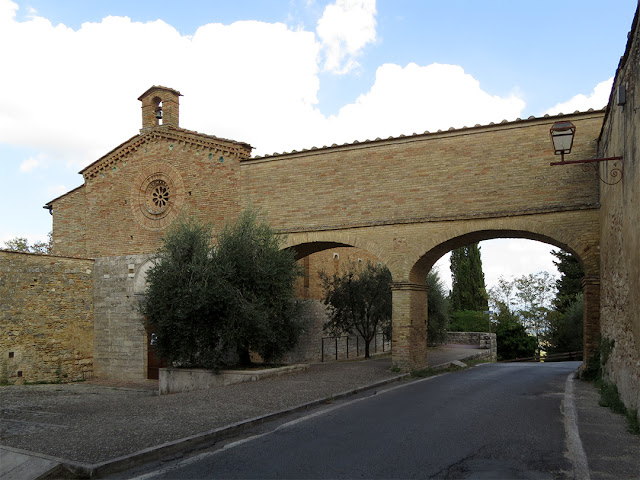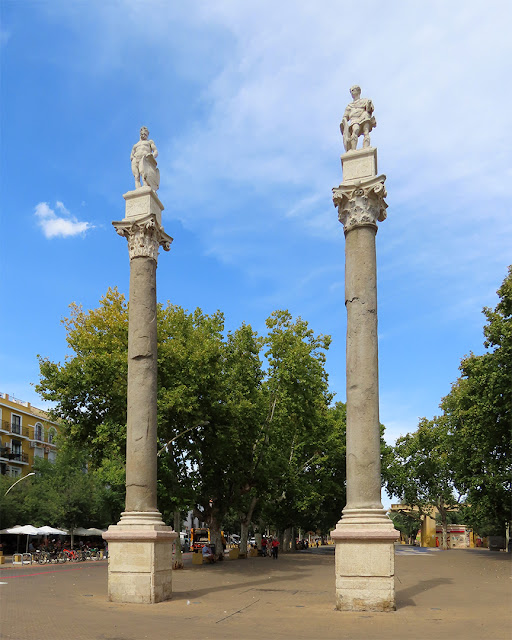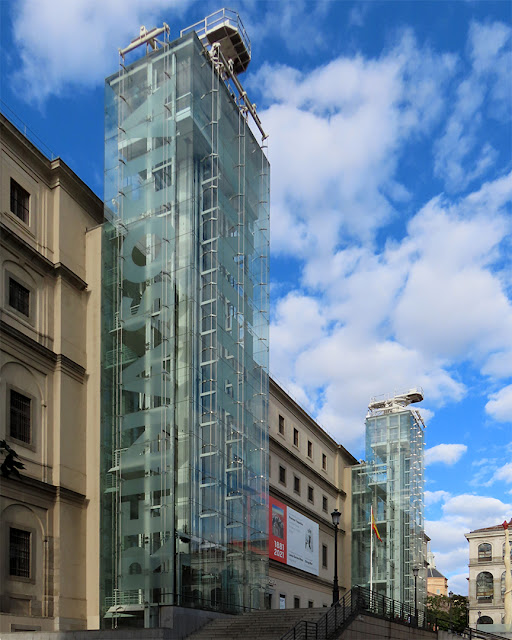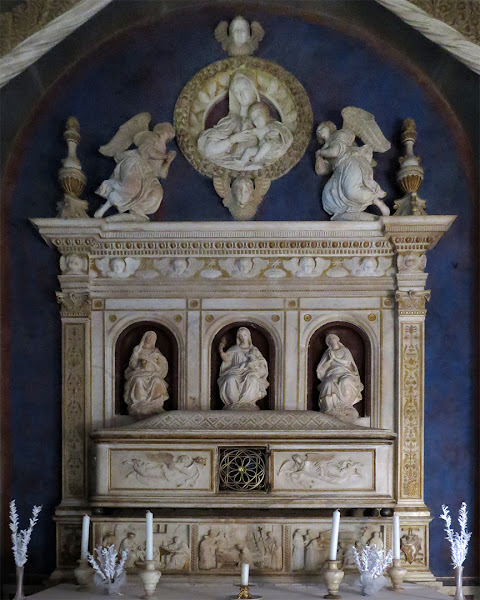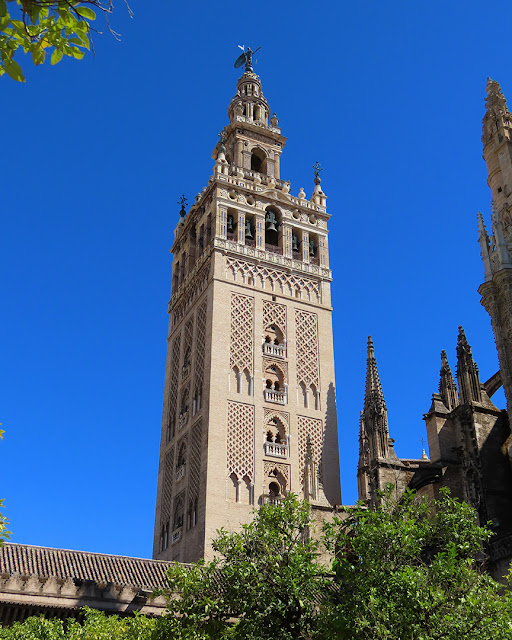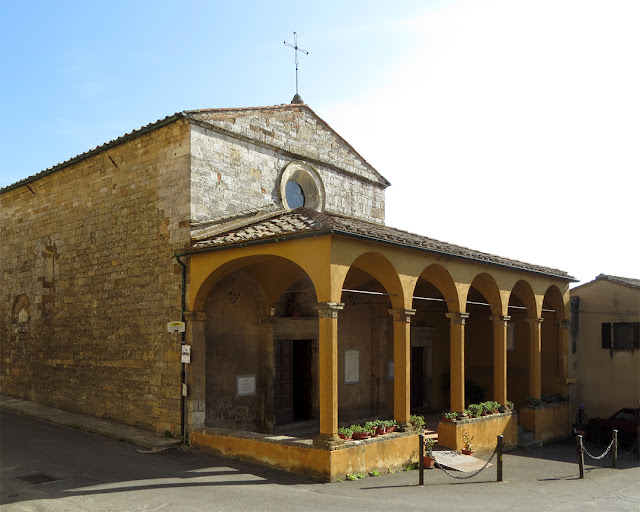Friday, March 31, 2023
Plaça Redona
Plaça Redona (Plaza Redonda, Round Square)
Calles Pescaderia
Valencia, September 2022
“Constructed by Salvador Escrig Melchor in 1840, the Plaza Redonda is one of Valencia’s most unique tourist attractions due to its peculiar design. Restored in 2012, this space has become one of the city’s most enchanting spots. Surrounded by traditional craft shops and tapas bars at street level, you can also browse the small stalls that sell lace, embroidery, fabrics and Valencian souvenirs, among other things. You can reach the square on foot via four streets that converge together to form an area which is welcoming and full of light. If you stand by the fountain in the centre, you can take in a new and beautiful view of the Late Baroque bell tower of Santa Catalina, which stands over the three stories of the round building. On the ground, there is a quote by the Valencian writer Vicente Blasco Ibáñez who mentions this place in his novel Arroz y Tartana.” (Round Square, Visit Valencia)
Thursday, March 30, 2023
Porta a Selci
Porta a Selci
Viale Vittorio Veneto
Volterra, September 2021
“The gate which leads to Siena, with a simple pointed arch was built in the 16th century to replace the earlier gate, known as the Sun Gate, destroyed when the fortress was erected in the 15th century.” (The Medieval Wall and the Gates, Volterra Online)
Wednesday, March 29, 2023
Sagrado Corazón de Jesús
Monumento al Sagrado Corazón de Jesús (Monument to the Sacred Heart of Jesus) by Juan García Ramírez, 1931
Plaza del Sagrado Corazón
Avenida de Carlos III
Toledo, September 2022
Tuesday, March 28, 2023
Monday, March 27, 2023
CaixaForum Madrid
CaixaForum Madrid
Paseo del Prado
Madrid, September 2022
“CaixaForum Madrid is a cultural center in Madrid, Spain. Located in Paseo del Prado in a former power station, it is owned by the not-for-profit banking foundation ‘la Caixa’. The art center opened its doors in 2008 and it hosts temporary art exhibitions and cultural events. It was designed by the Swiss architects Herzog & de Meuron and built by Ferrovial between 2001 and 2007. It was an old power station called Central Del Mediodía, from the 1900s. The Vertical Garden by Patrick Blanc at the square is also well-known.” (CaixaForum Madrid, Wikipedia)
Sunday, March 26, 2023
San Pietro in Selci
San Pietro in Selci
Via Don Giovanni Minzoni
Volterra, September 2021
“San Pietro in Selci is an ancient church in Volterra, Italy. A church was initially established by Guiscard, Marquis of Tuscany in 1005, and part of the building we see today dates to the 12th century, but sports today a later Baroque facade with statues in tufa of San Lino and Saint Giusto by Leonardo Ricciarelli. The interior contains a painting of a Madonna with Child and Saints by the 15th century Master of Volterra, two canvases by Niccolò Circignani depicting respectively an Annunciation and the Glory of the Virgin, a canvas by Francesco Brini depicting an Immaculate Conception and a painted stucco with a Madonna and Child.” (San Pietro in Selci, Wikipedia)
Saturday, March 25, 2023
Alminar de San Juan
Alminar de San Juan (Minaret of San Juan)
San Juan de los Caballeros
Plaza de San Juan
Córdoba, September 2022
“In the middle of the Jewish quarter of Cordoba we can find one of the most emblematic spots and one of the most striking towers of the Jewish quarter: the Minaret of San Juan. This construction was built at the end of the 9th century and it was one of the many medieval mosques in Cordoba at that time. From this minaret the faithful were called to prayer. After the Christian conquest, this building became part of the order of St John of the Knights who transformed the mosque into the Church of the same name. Thus converting the minaret into a bell tower. In 2018 it underwent a profound reform, where the minaret’s value was notably increased as it is part of the only examples of emirate architecture in Spain. These relics have been declared an Asset of General Interest. As you can see, the building is square in shape and is less than eleven meters high. Its body is made up of stone blocks arranged in rope and laid in headers with twin horseshoe arches on marble columns with Visigoth shafts. Its arches are made up of two-colored red brick keystones alternated with bio-calcarenite stone.” (The Minaret of San Juan, OWAY Tours)
Friday, March 24, 2023
Thursday, March 23, 2023
Alameda de Hércules
Roman columns with statues of Hercules and Julius Caesar
Alameda de Hércules
Seville, September 2022
“The Alameda de Hércules (Hercules mall), or simply La Alameda, is a garden square or mall in Seville, southern Spain. Built in 1574, it was originally a promenaded public garden, named after the eight rows of white poplar trees (álamos in Spanish) that fill its central part. Located in the northern half of the city's casco antiguo (historic center), between the Guadalquivir River and the Macarena neighbourhood, it was the oldest public garden in Spain and Europe.” (Alameda de Hércules, Wikipedia)
Wednesday, March 22, 2023
Palazzo dei Priori
Palazzo dei Priori
Piazza dei Priori
Volterra, September 2021
“The city hall is housed in the Palazzo dei Priori, one of the oldest palazzos still surviving in Tuscany. At almost 800 years old it is the province's oldest seat of continuous local government. This lavishly decorated building was the inspiration for the Palazzo Vecchio in Florence. An inscription near the main entrance tells visitors that the palace was designed by Maestro Riccardo in the early XIII century. The XII century witnessed decades of violent conflict between the nobility and the rule of bishops. This reached a climate mid-century when Galgano dei Pannocchieschi became the region's bishop. His rule was so unpopular that feudal lords and the town's growing middle classes united against him leading to the building of the Palazzo dei Priori as a symbol of the free commune. This newly formed commune purchased rights for the extraction of salt (the town's main source of income at the time), sulfur, vitriol or sulfuric acid, and alum from the surrounding areas of Larderello, Libbiano, and Sasso. However, the commune soon found itself struggling against the territorial expansion of Siena, Pisa and Florence. The three-story Palazzo dei Priori is built entirely of local stone. The facade is finished with cornices and crowned with semi-circular battlements, probably added in the XVI century. It is adorned with double arched windows and Della Robbia glazed terracotta arms of Florentine magistrates, added in the XV century. It also carries the canna volterrana, or medieval standard measurement of the commune, engraved between a banner and torch holders. In the late XV century, the palazzo became the seat of the Captain of Justice at which point two Marzocco lions, a Florentine symbol, were added to the facade.” (Palazzo dei Priori, ItalyGuide.it)
Tuesday, March 21, 2023
El Miguelete
El Miguelete
Plaza de la Reina
Valencia, September 2022
“This is the Valencian Gothic-style bell tower of Valncia Cathedral. It is 50.85 metres high and was built between 1381 and 1424 by Andrés Juliá and others. Access to the tower is from inside the Cathedral by means of a spiral staircase with 207 steps. An 18th century steeple crowns the Miguelete belfry.” (El Miguelete, Visit Valencia)
Monday, March 20, 2023
Madonna in Gloria
“Madonna in Gloria” (Madonna in Glory) by Simone Martini, 1310ca (Cenni di Francesco, 1413) Church of San Lorenzo al Ponte
Via Santo Stefano
San Gimignano, September 2021
Sunday, March 19, 2023
Puente de San Martín
Puente de San Martín (San Martin's Bridge)
Bajada San Martín
Toledo, September 2022
“The Puente de San Martín (English: St Martin's Bridge) is a medieval bridge across the river Tagus in Toledo, Spain. The Puente de San Martín features five arches, with the largest in the middle having a span of 40 meters. Only very few bridges in the world were that long at the time of its construction. The bridge was constructed in the late 14th century by archbishop Pedro Tenorio to provide access to the old town from the west, complementing the older Puente de Alcántara linking to the east. Both sides of the bridge were heavily fortified with towers, the more recent dating from the 16th century.” (Puente de San Martín, Wikipedia)
Saturday, March 18, 2023
Porta San Francesco
Porta San Francesco
Via San Lino
Volterra, September 2021
“This gate is also known as the Gate of Santo Stefano or the Pisan Gate as it leads to Pisa through the Era valley. It is the only gate that still preserves traces of the original frescoes painted in the vaults and an engraving of the Pisan canna, a unit of length, slightly longer than that of Volterra engraved on the façade of the Palazzo dei Priori” (The Medieval Wall and the Gates, Volterra Online)
Friday, March 17, 2023
Centro de Arte Reina Sofía
Museo Nacional Centro de Arte Reina Sofía
Calle de Santa Isabel
Madrid, September 2022
“The Museo Nacional Centro de Arte Reina Sofía (Queen Sofía National Museum Art Centre; MNCARS) is Spain's national museum of 20th-century art. The museum was officially inaugurated on September 10, 1992, and is named for Queen Sofía. It is located in Madrid, near the Atocha train and metro stations, at the southern end of the so-called Golden Triangle of Art (located along the Paseo del Prado and also comprising the Museo del Prado and the Museo Thyssen-Bornemisza). The museum is mainly dedicated to Spanish art. Highlights of the museum include excellent collections of Spain's two greatest 20th-century masters, Pablo Picasso and Salvador Dalí. The most famous masterpiece in the museum is Picasso's 1937 painting Guernica. Along with its extensive collection, the museum offers a mixture of national and international temporary exhibitions in its many galleries, making it one of the world's largest museums for modern and contemporary art. In 2021, due to the COVID-19 pandemic restrictions, it attracted 1,643,108 visitors, up 32 percent from 2020, but well below 2019 attendance. In 2021 It ranked eighth on the list of most-visited art museums in the world.” (Museo Nacional Centro de Arte Reina Sofía, Wikipedia)
Thursday, March 16, 2023
Palazzo Comunale
Palazzo Comunale (Municipal Palace) and Torre Grossa (Great Tower)
Piazza del Duomo
San Gimignano, September 2021
“The Palazzo Comunale dates from the late 13th century, and was built on the ruins of an existing building between 1289 and 1298. Further expanded in the 14th century, the facade is characterised by arched windows, with the lower half of the frontage built with stone, and the upper part in brick. On the ground floor is a courtyard, which was built in 1323 and is decorated with the coats of arms of those who have held public office in the municipality. The main civic offices of the town council are now located on this ground floor. On the first floor is a stepped gallery from which dignitaries would address the gathered crowd in the square. The battlements date from a restoration of the nineteenth century,[4] and the structure is capped by the ‘Torre Grossa’ (great tower). This tower was completed in 1300 and (at 54 meters) is the highest tower in the walled town.” (Palazzo Comunale, Wikipedia)
Wednesday, March 15, 2023
Zoco Municipal
Zoco Municipal - Mercado de la Artesanía
Calle Judíos
Córdoba, September 2022
“El Zoco or The Souk is the Municipal Souk of Córdoba, in Spain. It is also known as Mercado de la Artesanía. It is located within the historic center of Cordoba in the Jewish Quarter, very close to the Mosque and the Synagogue. It was the first craft market that was created in Spain, and local artisans offer you for your enjoyment leather, ceramic and silver goods.” (El Zoco, Nomad's Travel Guide)
Tuesday, March 14, 2023
Church of San Giusto
Church of San Giusto
Piazzale XXV Aprile
Volterra, September 2021
“The Church of Santi Giusto e Clemente (Saints Justin and Clement) is an ancient church in Volterra, Pisa, Italy. It is also known as San Giusto or San Giusto Nuovo. For some 850 years, the Abbey of Sts. Justin and Clement was attached to it, and it was administered by the monks of that monastery. Construction of the present stone church was begun on October 28, 1628, based on designs by the architect Giovanni Coccapani, which were carried out by his pupil Ludovico Incontri. The new church was consecrated in 1775.” (Church of San Giusto, Wikipedia)
Monday, March 13, 2023
Torre Schindler
Torre Schindler by Guillermo Vázquez Consuegra, 1992
Pabellón de la Navegación
Camino de los Descubrimientos
Isla de la Cartuja
Seville, September 2022
“Originally built as an observation tower for the 1992 Expo, the 50m-high Torre Schindler is now part of the Pabellón de la Navegación museum. Elevators take you to the top, from where you can admire sweeping views of the city.” (Torre Mirador, Lonely Planet)
Sunday, March 12, 2023
Chapel of San Bartolo
Marble altar by Benedetto da Maiano
Chapel of San Bartolo
Church of Sant'Agostino
Piazza Sant'Agostino
San Gimignano, September 2021
“The Cappella di San Bartolo houses the remains of the eponymous saint (1228–1300), a lay Franciscan who died of leprosy. The magnificent altar in the chapel is by Benedetto da Maiano.” (Sant'Agostino, Wikipedia)
Saturday, March 11, 2023
Fuente del Turia
Fuente del Turia by Manuel Silvestre Montesinos, 1976
Plaza de la Virgen
Valencia, September 2022
“The Turia Fountain is an elaborate oval fountain about 60' across by 26' wide. It was created by sculptor Silvestre Edeta and dedicated in 1976. A bronze statue of the Roman god Neptune sits on a platform is in the center with a cascade of water flowing down to a lower level from all sides. The lower level contains bronze sculptures of eight naked women. The fountain is an allegorical representation of Valencia’s Turia River. The eight statues of women have water pouring from jars representing the irrigation channels of the river.” (Turia Fountain, Waymarking)
Friday, March 10, 2023
Madonna and Child
Madonna and Child by Mariotto di Andrea, 15th century
Oratorio di San Cristoforo
Via Franceschini
Volterra, September 2021
Thursday, March 9, 2023
Bancos
Bancos (Benches)
Plaza de Zocodover
Toledo, September 2022
“The second expansion was done and dates from the beginning of the 17th century. This consisted in the demolition of a series of houses of little value that seems to be difficult the total vision of Zocodover from its top to the bottom and vice versa. Never more arches were realized and probably this fact is due to that it was not wanted to remove meters to the square. Nowadays Zocodover is one of the places of the city where many events and celebrations are held, as well as serving as a popular meeting point and enjoyment of the Toledo and above all a must for the thousands of tourists who mark the streets of the historical quarter throughout the year.” (Plaza de Zocodover, Wikipedia)
Wednesday, March 8, 2023
Church of St Augustine
Church of Sant'Agostino
Piazza Sant'Agostino
San Gimignano, September 2021
“The interior is a large hall dominated by the seventeen-panel fresco cycle on The Life of St Augustine around the high altar, painted by Benozzo Gozzoli between 1463 and 1467. The altarpiece is the Coronation of the Virgin by Piero del Pollaiuolo (1483). There are a number of other frescoes in the church.” (Sant'Agostino, Wikipedia)
Tuesday, March 7, 2023
Fuente de Cibeles
Fuente de Cibeles (Fountain of Cybele) by Ventura Rodríguez, 1782
Plaza de Cibeles
Madrid, September 2022
“The Fountain of Cybele is a neoclassical fountain in Madrid, Spain. It lies on the centre of the Plaza de Cibeles. The sculptural group in its centre represents Cybele, a Phrygian earth and fertility deity. It has become one of the icons of the city. Designed and commissioned by Ventura Rodríguez in 1780, the sculptural group—made of white marble from Montesclaros—is a work by Francisco Gutiérrez (goddess) and Roberto Michel (the lions). Crowned by a mural crown, the goddess rides a chariot pulled by two lions, representing Atalanta and Hippomenes. It was moved to its current location and orientation in 1895. It has a maximum water capacity of 278 m3. The fountain is the site where Real Madrid's supporters and players gather to celebrate the team's trophies as well as partakers of the successes of the Spain national football team. The goddess lost a hand in 1994, following a celebration of a victory of the Spanish national team. The goddess lost again one of her hands on 21 September 2002. The Fountain of Cybele has a replica, the namesake Fuente de Cibeles, located in Mexico City and inaugurated in 1980.” (Fountain of Cybele, Wikipedia)
Monday, March 6, 2023
Sunday, March 5, 2023
Ave del paraíso
Ave del paraíso (Bird of paradise)
Paseo de la Victoria, 35
Córdoba, September 2022
“Strelitzia is a genus of five species of perennial plants, native to South Africa. It belongs to the plant family Strelitziaceae. The genus is named after Queen Charlotte of the United Kingdom, who was born a princess of the house of Mecklenburg-Strelitz. A common name of the genus is bird of paradise flower/plant, because of a resemblance of its flowers to birds-of-paradise. In South Africa, it is commonly known as a crane flower and is featured on the reverse of the 50-cent coin. It is the floral emblem of the City of Los Angeles; two of the species, S. nicolai and S. reginae, are frequently grown as houseplants.” (Strelitzia, Wikipedia)
Saturday, March 4, 2023
Sant'Agostino
Church of Sant'Agostino
Piazza Sant'Agostino
San Gimignano, September 2021
“The chiesa di Sant'Agostino (Church of St Augustine) is the second largest church in San Gimignano, Italy, after the Collegiata. It is owned by the Order of Saint Augustine. Sant'Agostino is an imposing 13th century building.” (Sant'Agostino, Wikipedia)
Friday, March 3, 2023
La Giralda
La Giralda
Avenida de la Constitución
Seville, September 2022
“The Giralda (Spanish: La Giralda) is the bell tower of Seville Cathedral in Seville, Spain.[1] It was built as the minaret for the Great Mosque of Seville in al-Andalus, Moorish Spain, during the reign of the Almohad dynasty, with a Renaissance-style belfry added by the Catholics after the expulsion of the Muslims from the area. The Giralda was registered in 1987 as a World Heritage Site by UNESCO, along with the Alcázar and the General Archive of the Indies. The tower is 104.1 m (342 ft) in height and remains one of the most important symbols of the city, as it has been since the Middle Ages.” (Giralda, Wikipedia)
Thursday, March 2, 2023
Church of Sant'Alessandro
Church of Sant'Alessandro
Borgo Sant'Alessandro
Volterra, September 2021
“The ancient roots of the church seem to date back to a pagan temple, whereas the church was consecrated in 1120 by Pope Callixtus II. Built with sandstone ashlar, it has a simple structure with a beamed ceiling and a square choir. A loggia from the 16th century hides part of the facade, which is refined by three big arches on top of pilaster strips with a semi-pillar. The door to the church is under the central arch, whereas the steps under the side-arches lead to the door itself. On the left side of the building, there’s a 13th-century-lunette portraying a hunting scene over a small now sealed up door. A painting of a cross by a Tuscan artist dating back to the 12th century is kept in the church. There are also two panels portraying Saints Atinia and Greciniana, two of the few remaining parts of the majestic altar made by Cosimo Daddi in the 16th century. A 15th-century-tabernacle is located on the right wall of the presbytery. It originally comes from the Santi Pietro e Paolo church in Coiano, in the municipality of Castelfiorentino, Valdelsa, but is part of Volterra’s diocese.” (The Sant'Alessandro Church in Volterra, VolterraTur)
Wednesday, March 1, 2023
Torres de Serranos
Torres de Serranos (Serranos Towers)
Plaza de los Fueros
Valencia, September 2022
“Under the supervision of Pere Balaguer, construction began in 1392. The towers were designed to be defensive structures at one of the busiest city gates. They were saved from demolition when the city walls were knocked down in 1865 and used as a prison for the nobility between 1586 and 1887. The back of the towers have been opened so that the pointed arches and the vaulted domes can now be seen from the Plaza de los Fueros. The Towers represent an excellent example of gothic architecture.” (Serranos Towers, Visit Valencia)
Subscribe to:
Posts (Atom)








